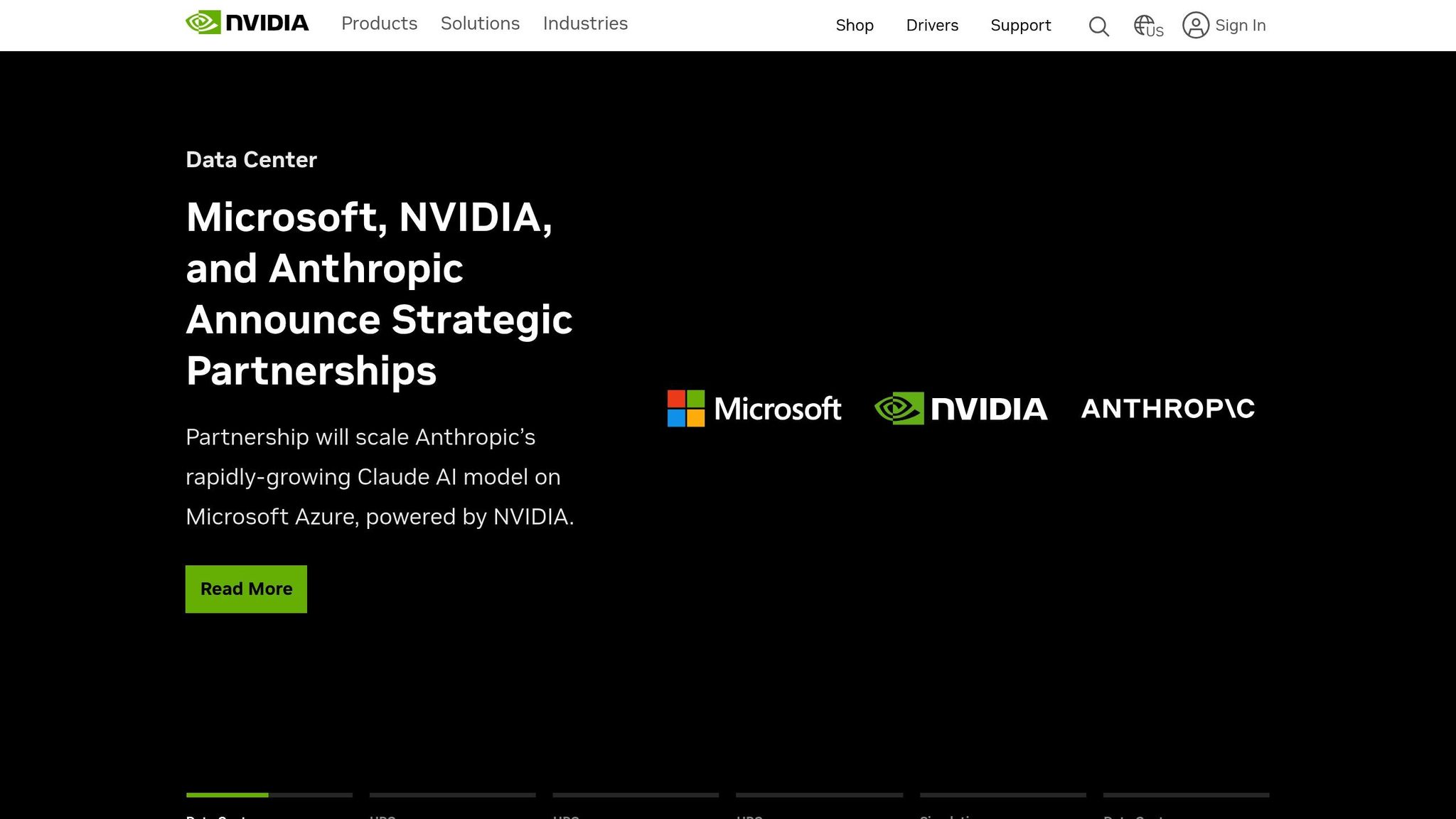OpenAI, Microsoft, and Nvidia have created a powerful growth cycle in the AI industry, driving advancements in software, hardware, and cloud services. Here's how it works:
- Nvidia supplies cutting-edge GPUs that power complex AI computations.
- OpenAI uses these GPUs to develop advanced AI models like ChatGPT.
- Microsoft provides the cloud infrastructure to deploy these models globally.
This partnership fuels continuous innovation, reshaping industries like software, content creation, and customer service. Each company’s progress boosts the others, creating a self-sustaining loop of growth. However, their interdependence also introduces risks, as challenges for one partner can ripple through the alliance.
The result? A thriving AI ecosystem projected to drive $7 trillion in economic impact, showcasing the potential of strategic collaboration in tech.
1. OpenAI

Core Contributions
OpenAI has been a driving force in advancing artificial intelligence, reshaping how both businesses and individuals engage with technology. One standout achievement is ChatGPT, a conversational AI model that utilizes cutting-edge technology to deliver highly effective and natural interactions.
The progression of OpenAI's GPT series has been a game-changer for natural language processing. The latest iterations of these models excel at tackling creative challenges and solving complex problems. Beyond simply processing text, these models understand context, generate responses that feel authentically human, and adapt seamlessly to a variety of applications across industries.
OpenAI's API ecosystem has also become a key enabler for businesses. Companies across multiple sectors have integrated these models into their platforms, enhancing user experiences and unlocking fresh revenue streams.
None of this would be possible without the critical technical support provided by OpenAI's strategic partners.
Synergistic Dependencies
OpenAI's breakthroughs are deeply intertwined with the expertise and resources of its key collaborators. For instance, Nvidia's GPUs play a pivotal role in powering OpenAI's large-scale models. These advanced processors provide the computational muscle needed to achieve the scale and performance required for AI innovation.
On the other hand, Microsoft's cloud infrastructure has been a cornerstone of OpenAI's operations. With access to Microsoft's vast network of data centers and technical resources, OpenAI has been able to ensure reliable, scalable services on a global level. Microsoft's significant financial investments have further propelled OpenAI's technological and operational growth.
This partnership is a two-way street. OpenAI's advancements create demand for more powerful hardware, driving Nvidia to develop faster and more efficient chips. Simultaneously, the growing computational requirements of AI models push Microsoft to expand and optimize its cloud infrastructure. Together, these collaborations not only advance technology but also influence the broader market landscape.
Market Impact
The ripple effects of OpenAI's work are being felt across the AI industry. Its innovations have redefined the possibilities of AI, giving rise to entirely new categories of software and services. Businesses in various sectors have adopted AI-powered tools, fueling the expansion of the enterprise AI market. This wave of innovation has also intensified competition among major tech companies, leading to increased investment in AI research and accelerating progress across the industry.
OpenAI's move to a subscription model for premium services has further demonstrated the commercial viability of AI, encouraging broader market adoption. These advancements, bolstered by the infrastructure and support of its partners, contribute to the growing momentum of the AI industry - an industry projected to drive $7 trillion in economic impact. This highlights how strategic collaborations can spark exponential growth and reshape entire markets.
The $1 Trillion Tangled Web Of AI Deals Mapped Out
2. Microsoft
Microsoft plays a pivotal role in advancing AI, seamlessly connecting AI development, hardware innovation, and cloud infrastructure.
Core Contributions
At the heart of Microsoft's AI strategy is its Azure cloud platform and a massive $13 billion investment in OpenAI. This funding and infrastructure are essential for training and deploying large language models.
Azure provides a robust foundation for AI applications, offering specialized tools like machine learning services, cognitive APIs, and pre-built AI models. With its extensive network of global data centers, Azure ensures fast, reliable access for developers and enterprises alike.
Microsoft has also integrated AI into its flagship products through Microsoft 365 Copilot. This upgrade breathes new life into tools like Word, Excel, PowerPoint, and Outlook, opening up fresh revenue opportunities while keeping users more engaged than ever.
Synergistic Dependencies
Microsoft's AI ecosystem heavily relies on Nvidia's cutting-edge GPUs to power Azure. These GPUs are critical for handling the intense computational needs of AI developers and businesses.
The partnership with OpenAI has been transformative for Microsoft. By providing the computational infrastructure OpenAI needs, Microsoft has positioned itself as a leader in AI services. In return, OpenAI's advancements give Microsoft a competitive edge, enabling it to rival Google and Amazon in the AI cloud market.
This collaboration has also driven demand for more powerful hardware. As businesses increasingly adopt Microsoft's AI tools, the company must continually expand its data centers and upgrade to the latest GPU technologies. This creates a cycle where Nvidia benefits from hardware demand, while Microsoft strengthens its cloud infrastructure to stay ahead in AI workloads.
Market Impact
Microsoft's AI initiatives are redefining cloud computing and enterprise software. The introduction of Microsoft 365 Copilot has raised the bar for competitors, pushing them to accelerate their AI adoption strategies.
Businesses have shown strong enthusiasm for Microsoft's AI solutions, with many opting for Azure due to its advanced AI capabilities and seamless integration with Microsoft's software ecosystem. This shift has helped Microsoft gain ground in the cloud market, positioning Azure as a top choice for companies implementing AI.
Microsoft's approach has also influenced the broader tech industry. Its strategy of combining substantial financial investment with infrastructure support has set a benchmark for other companies aiming to dominate specific AI markets. This has spurred greater investment in AI research and development, contributing to the industry's rapid growth and its projected $7 trillion economic impact.
sbb-itb-9cd970b
3. Nvidia

Nvidia is at the heart of modern AI advancements, thanks to its high-performance GPUs and the CUDA platform, which enable the parallel processing required for large-scale model training and machine learning. Beyond hardware, Nvidia has ventured into AI software tools, offering researchers and developers the resources they need to push the boundaries of AI.
Core Contributions
Nvidia's GPUs are a cornerstone of AI, providing the computational muscle behind advanced machine learning and AI applications. The CUDA software platform enhances this by enabling developers to tap into GPU computing for complex machine learning tasks. Together, these tools create a cohesive ecosystem that goes beyond hardware, making Nvidia a key player in AI development.
This blend of powerful hardware and versatile software tools elevates Nvidia from being just a chip manufacturer to a driving force behind AI progress across various industries.
Synergistic Dependencies
Nvidia's growth in the AI sector is deeply connected to the strides made by major players like Microsoft and OpenAI. As these companies push the limits of AI, the demand for Nvidia's high-performance GPUs continues to climb. This symbiotic relationship not only accelerates AI adoption but also reinforces Nvidia's position as a leader in the market.
Market Impact
Nvidia's influence in the AI hardware market is clearly reflected in its market performance, drawing attention from both investors and industry experts. The company's success highlights the critical role of advanced computing infrastructure in powering the next wave of AI innovations. At the same time, supply constraints emphasize just how essential Nvidia's hardware is for driving these advancements forward.
Pros and Cons of the Partnership Model
The collaboration between OpenAI, Microsoft, and Nvidia showcases how combining strengths can push boundaries in innovation and secure a commanding position in the market. By pooling resources and expertise, these companies create a synergy that speeds up development and expands market reach. However, this interconnectedness also introduces shared vulnerabilities - if one partner encounters issues, the ripple effects could impact the entire alliance.
Here’s a breakdown of the benefits and risks each company faces in this partnership:
| Company | Advantages | Disadvantages |
|---|---|---|
| OpenAI | Gains substantial funding and access to powerful cloud infrastructure; utilizes cutting-edge GPU technology to improve AI model training; lowers hardware costs | Becomes reliant on a partner's cloud services; depends on external hardware suppliers; risks misalignment in strategic goals with partners |
| Microsoft | Secures early access to advanced AI models, enhancing its core services and enterprise offerings; benefits from the growth of AI-driven solutions | Faces investment risks; could attract regulatory scrutiny for market dominance; depends on partners to maintain innovation momentum |
| Nvidia | Experiences steady demand for its GPUs from leading AI projects; bolsters its reputation in specialized AI hardware; validates its technology through high-profile use cases | Risks overreliance on a rapidly growing market segment; may face customer concentration issues; pressured to stay ahead in a highly competitive space |
While this partnership accelerates progress, it also amplifies certain risks. For instance, challenges faced by one partner can cascade through the alliance, and the concentrated market power may reduce diversity in the industry. These dynamics are a key part of the $7 trillion AI ecosystem, presenting both immense opportunities and notable challenges for everyone involved.
Conclusion: Lessons from the AI Flywheel
The $7 trillion AI flywheel built by OpenAI, Microsoft, and Nvidia offers a roadmap for creating powerful partnerships in the SaaS and AI industries. Their approach highlights a few key strategies that other businesses can adopt: significant financial investment, vertical integration, and leveraging complementary strengths effectively.
At the heart of this flywheel is financial investment. Microsoft's $13 billion backing of OpenAI aligned the goals of both companies, setting the stage for shared growth [1]. Similarly, Nvidia's plan to invest $100 billion into building 10 gigawatts of next-generation AI infrastructure underscores the scale of commitment needed [2]. For SaaS companies, this suggests exploring partnerships that go beyond standard vendor relationships - considering equity stakes or revenue-sharing agreements that align interests and foster shared success.
Microsoft's vertical integration is another critical piece of the puzzle. By embedding AI into products like Office, GitHub Copilot, and Azure, they’ve diversified revenue streams and strengthened their competitive edge. For SaaS businesses, forming alliances that enhance and expand their core offerings can be a game-changer.
When these investments and integrations come together, they create a self-sustaining growth loop. OpenAI's cutting-edge models, Microsoft's scalable cloud infrastructure, and Nvidia's specialized hardware work in harmony. As OpenAI improves its models, Microsoft's services benefit, driving further adoption and fueling growth. This cycle becomes a powerful engine that competitors find hard to replicate.
The takeaway here is clear: well-designed partnerships can build enduring competitive advantages and unlock long-term growth opportunities.
FAQs
How do OpenAI, Microsoft, and Nvidia work together to drive a $7 trillion impact in the AI industry?
OpenAI, Microsoft, and Nvidia have teamed up, blending their expertise to drive forward the AI industry in groundbreaking ways. Nvidia brings its state-of-the-art GPUs to handle the immense computational demands of OpenAI's advanced language models. Meanwhile, Microsoft steps in with its scalable cloud infrastructure, ensuring these technologies can operate seamlessly at scale. Together, they form a powerful cycle of innovation and adoption.
This partnership doesn’t just push the boundaries of AI development - it also generates immense economic value, with an estimated $7 trillion impact on the horizon. Their collaboration highlights how strategic alliances can unlock vast opportunities across the AI and SaaS landscapes.
What challenges could arise from the collaboration between OpenAI, Microsoft, and Nvidia?
The collaboration between OpenAI, Microsoft, and Nvidia is undeniably driving progress and pushing boundaries. However, it’s not without its potential downsides. One key concern is the risk of over-reliance. If one company encounters issues - like supply chain disruptions or technical hurdles - it could ripple across the partnership, creating vulnerabilities. This close interdependence might also reduce competition in the AI and SaaS sectors, potentially making it harder for smaller players to bring fresh ideas to the table.
Another pressing issue is the breakneck speed of AI development, which may outstrip the ability of regulatory frameworks to keep up. This gap could lead to ethical dilemmas or societal challenges. For businesses exploring similar collaborations, it’s wise to diversify partnerships and keep a close eye on shifting market trends to navigate these risks effectively.
How does integrating AI into products like Microsoft 365 Copilot improve user engagement and create revenue opportunities?
Microsoft has woven AI into products like Microsoft 365 Copilot to make daily tasks feel more seamless and efficient. With features like AI-powered suggestions, automated repetitive tasks, and advanced natural language processing, users can get more done in less time. This not only streamlines workflows but also enhances overall productivity and user satisfaction.
From a business standpoint, these AI-driven tools are a game-changer. They offer premium features that justify higher subscription plans, creating added value for users. Plus, they appeal to a broad range of industries looking to optimize workflows and improve decision-making. This combination drives increased adoption and positions Microsoft for continued growth in the SaaS market.
Related Blog Posts
- AI Native SaaS The New Blueprint for Startups Scaling to 8 Figures
- Musk’s “Inside Game”: How xAI Buying X Rewrote a ‘Bad LBO’ Narrative
- The SaaS Valuation Gap: Why Typical Firms Stall at 4-6× While AI-Enabled Ones Hit 10×+
- How Disney Built the Ultimate Flywheel - and What AI Companies Can Learn From It



